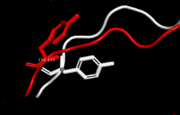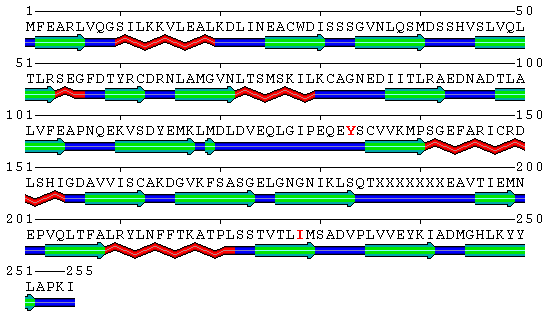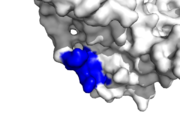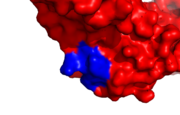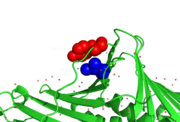User:Lukáš Cakl/Sandbox 1
From Proteopedia
| |||||||||||
Credits
Article created as an Structural biology of the cell assignment at the Faculty of Science, Charles University, Prague, Czech Republic.
Assignment author: Lukáš Cakl
References
- ↑ Duffy CM, Hilbert BJ, Kelch BA. A Disease-Causing Variant in PCNA Disrupts a Promiscuous Protein Binding Site. J Mol Biol. 2016 Mar 27;428(6):1023-40. doi: 10.1016/j.jmb.2015.11.029. Epub 2015, Dec 11. PMID:26688547 doi:http://dx.doi.org/10.1016/j.jmb.2015.11.029
- ↑ Fay PJ, Johanson KO, McHenry CS, Bambara RA. Size classes of products synthesized processively by two subassemblies of Escherichia coli DNA polymerase III holoenzyme. J Biol Chem. 1982 May 25;257(10):5692-9. PMID:7040370
- ↑ Yao NY, Georgescu RE, Finkelstein J, O'Donnell ME. Single-molecule analysis reveals that the lagging strand increases replisome processivity but slows replication fork progression. Proc Natl Acad Sci U S A. 2009 Aug 11;106(32):13236-41. doi:, 10.1073/pnas.0906157106. Epub 2009 Aug 3. PMID:19666586 doi:http://dx.doi.org/10.1073/pnas.0906157106
- ↑ McInerney P, Johnson A, Katz F, O'Donnell M. Characterization of a triple DNA polymerase replisome. Mol Cell. 2007 Aug 17;27(4):527-38. doi: 10.1016/j.molcel.2007.06.019. PMID:17707226 doi:http://dx.doi.org/10.1016/j.molcel.2007.06.019
- ↑ Matsumoto Y, Kim K, Hurwitz J, Gary R, Levin DS, Tomkinson AE, Park MS. Reconstitution of proliferating cell nuclear antigen-dependent repair of apurinic/apyrimidinic sites with purified human proteins. J Biol Chem. 1999 Nov 19;274(47):33703-8. doi: 10.1074/jbc.274.47.33703. PMID:10559261 doi:http://dx.doi.org/10.1074/jbc.274.47.33703
- ↑ Lee SH, Hurwitz J. Mechanism of elongation of primed DNA by DNA polymerase delta, proliferating cell nuclear antigen, and activator 1. Proc Natl Acad Sci U S A. 1990 Aug;87(15):5672-6. doi: 10.1073/pnas.87.15.5672. PMID:1974050 doi:http://dx.doi.org/10.1073/pnas.87.15.5672
- ↑ Sanchez R, Pantoja-Uceda D, Prieto J, Diercks T, Marcaida MJ, Montoya G, Campos-Olivas R, Blanco FJ. Solution structure of human growth arrest and DNA damage 45alpha (Gadd45alpha) and its interactions with proliferating cell nuclear antigen (PCNA) and Aurora A kinase. J Biol Chem. 2010 Jul 16;285(29):22196-201. Epub 2010 May 11. PMID:20460379 doi:10.1074/jbc.M109.069344
- ↑ Kullmann F, Fadaie M, Gross V, Knuchel R, Bocker T, Steinbach P, Scholmerich J, Ruschoff J. Expression of proliferating cell nuclear antigen (PCNA) and Ki-67 in dysplasia in inflammatory bowel disease. Eur J Gastroenterol Hepatol. 1996 Apr;8(4):371-9. PMID:8781908
- ↑ De Biasio A, de Opakua AI, Mortuza GB, Molina R, Cordeiro TN, Castillo F, Villate M, Merino N, Delgado S, Gil-Carton D, Luque I, Diercks T, Bernado P, Montoya G, Blanco FJ. Structure of p15(PAF)-PCNA complex and implications for clamp sliding during DNA replication and repair. Nat Commun. 2015 Mar 12;6:6439. doi: 10.1038/ncomms7439. PMID:25762514 doi:http://dx.doi.org/10.1038/ncomms7439
- ↑ doi: https://dx.doi.org/10.1016/S0092-8674(00)81347-1
- ↑ Bruning JB, Shamoo Y. Structural and thermodynamic analysis of human PCNA with peptides derived from DNA polymerase-delta p66 subunit and flap endonuclease-1. Structure. 2004 Dec;12(12):2209-19. PMID:15576034 doi:http://dx.doi.org/10.1016/j.str.2004.09.018
- ↑ Larsen E, Kleppa L, Meza TJ, Meza-Zepeda LA, Rada C, Castellanos CG, Lien GF, Nesse GJ, Neuberger MS, Laerdahl JK, William Doughty R, Klungland A. Early-onset lymphoma and extensive embryonic apoptosis in two domain-specific Fen1 mice mutants. Cancer Res. 2008 Jun 15;68(12):4571-9. doi: 10.1158/0008-5472.CAN-08-0168. PMID:18559501 doi:http://dx.doi.org/10.1158/0008-5472.CAN-08-0168
- ↑ Duffy CM, Hilbert BJ, Kelch BA. A Disease-Causing Variant in PCNA Disrupts a Promiscuous Protein Binding Site. J Mol Biol. 2016 Mar 27;428(6):1023-40. doi: 10.1016/j.jmb.2015.11.029. Epub 2015, Dec 11. PMID:26688547 doi:http://dx.doi.org/10.1016/j.jmb.2015.11.029
- ↑ Duffy CM, Hilbert BJ, Kelch BA. A Disease-Causing Variant in PCNA Disrupts a Promiscuous Protein Binding Site. J Mol Biol. 2016 Mar 27;428(6):1023-40. doi: 10.1016/j.jmb.2015.11.029. Epub 2015, Dec 11. PMID:26688547 doi:http://dx.doi.org/10.1016/j.jmb.2015.11.029
- ↑ Lau PJ, Flores-Rozas H, Kolodner RD. Isolation and characterization of new proliferating cell nuclear antigen (POL30) mutator mutants that are defective in DNA mismatch repair. Mol Cell Biol. 2002 Oct;22(19):6669-80. doi: 10.1128/mcb.22.19.6669-6680.2002. PMID:12215524 doi:http://dx.doi.org/10.1128/mcb.22.19.6669-6680.2002
- ↑ Reijns MA, Rabe B, Rigby RE, Mill P, Astell KR, Lettice LA, Boyle S, Leitch A, Keighren M, Kilanowski F, Devenney PS, Sexton D, Grimes G, Holt IJ, Hill RE, Taylor MS, Lawson KA, Dorin JR, Jackson AP. Enzymatic removal of ribonucleotides from DNA is essential for mammalian genome integrity and development. Cell. 2012 May 25;149(5):1008-22. doi: 10.1016/j.cell.2012.04.011. Epub 2012 May , 10. PMID:22579044 doi:http://dx.doi.org/10.1016/j.cell.2012.04.011
